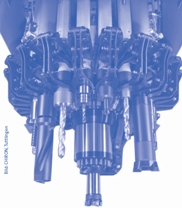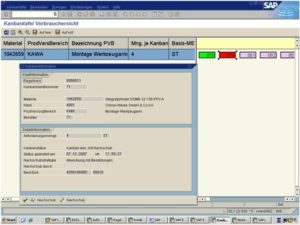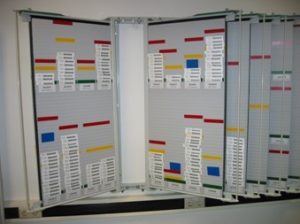KANBAN. Just-in-time assembly now ensures increased flexibility and reduced stock levels at Chiron. Kanban makes processes transparent.

Chiron recently introduced a Kanban system under SAP for the introduction of just-in-time assembly (JIT) of tool arms for changing workpieces in CNC production centers and for the procurement and production of the required assemblies and components. The aim of this switch to JIT was, on the one hand, to improve delivery readiness and, on the other, to reduce stock levels. During implementation with SAP, a number of things had to be taken into account in order to optimally adjust shortened throughput times, reduced stock levels, high flexibility and delivery readiness. The aim was to implement a card Kanban system with a connection to the SAP Kanban system. This should be ensured without adjustment programming. Many details had to be considered in order to ensure a successful Kanban introduction, as the concept was not “standardized” according to SAP, but developed in a function-optimized way. The requirement to implement a collective Kanban with traffic light control in SAP was particularly difficult, as the SAP standard does not offer collective Kanban as an independent function. In the SAP standard, a production order is triggered for each Kanban container instead, to which the stored setup times are also posted. Collecting the Kanban containers until the required batch size is reached and only generating a Kanban production order with a setup time using this batch size was only possible without adjustment programming by combining two SAP control cycles – consisting of batch production Kanban and stock transfer Kanban.
Control loop dimensioning.
However, another requirement for an optimized Kanban system cannot be adequately implemented with SAP: control loop dimensioning. It must be carried out regularly, as there are always fluctuations in customer demand, changes in production processes and production parameters. Normally, however, control cycle dimensioning is only carried out using the “classic” Kanban formula, which is also used in the SAP PP module. However, optimum Kanban control loops can only be achieved if other variables are also taken into account, such as the batch size of the supplier or customer, the consumption behavior of the item (XYZ behavior) or delivery reliability. For this reason, Chiron uses Kanban dimensioning from Abels & Kemmner. It takes the requirements of the tool arms from the SAP consumption or SAP SOP data and uses this to determine the BOM explosion for all kanban-controlled components. These values form the basis for dimensioning because they are used to determine the basic and safety stock for each component depending on the consumption behavior. The defined parameters of each individual component and a simulation period of five years are now used to test how many kanbans need to be fed into the system. The safety stock is constantly monitored to ensure that it is sufficient to prevent the system from running empty and that there are no excess Kanban containers circulating in the system.
The practice.

The changeover to JIT production with Kanban control first required an organizational change in the affected areas: The tool arm assembly was given a new assembly layout. Thanks to short set-up times and short throughput times, the tool arms can be assembled in batch size 1 and made available for final assembly at the production centers at short notice. The call-offs are triggered via the so-called event-driven SAP Kanban. The logistics center triggers its requirements in SAP and thus generates a production order in SAP, which is printed out immediately afterwards in the tool arm assembly department. It must meet its requirements with a maximum lead time of two days. The tool arms must then be ready for dispatch to the logistics center.
Problem Spare part.
Spare parts orders from customers, however, must in some cases be able to be served immediately and directly. To ensure this, a separate Kanban control cycle for spare parts was created in SAP. Control here is carried out classically via Kanban cards, which are attached to the tool arms. To ensure that sufficient components and assemblies are always available, the component store was designed as a Kanban store upstream of the tool arm assembly line to supply the tool arm assembly line. This approach made it possible to shift the increased warehousing away from the tool arm and back to a lower value-added stage (components instead of tool arms).
http://www.chiron-werke.de/
https://www.ak-online.de/
 From the push to the pull principle
From the push to the pull principle
In the Kanban system, which was originally developed in Japan, production or deliveries may only be made when a certain quantity of a certain article has been consumed at a certain point. Cards (Kanban) or the production/transport containers themselves serve as information carriers for communication between the producing and receiving areas. This means that material is only added according to actual consumption. Kanban is simple, it demands and promotes the autonomous control of production units and creates transparency regarding consumption and stocks.


